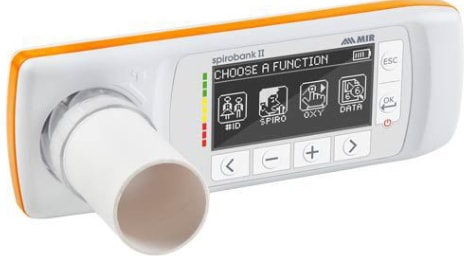13. Applications and implications¶
Objectives of this week are:
1- To propose a final project masterpiece that integrates the range of units covered.
Digital Incentive Spirometer Project (what will do and who has done what beforehand?)¶
One of the standard tests conducted in hospitals to measure the pulmonary functions is called the spirometry test. Spirometry test assess how well the human lungs are by using a device called spirometer. The spirometer measures the amount of air that patient can inhale and exhale during the respiratory system as well as the flow rate. The test is very safe and painless, it takes approximately 10 minutes to be completed.
The aim of the project is to design, build and test a prototype of a portable spirometer that measure the lung capacity and flow. Data obtained from the device will help in diagnosis some lung diseases (such as COPD and Asthma) by comparing the lung functions to the expected levels of functions. Also, the device can be used to monitor the progress of the patient health status after taking a series of medical sessions or after a surgery.
In the future, I am looking to transform the spirometer into a gaming controller as a base for a digital health and wellness platform that can be used to create mobile apps and games that address a variety of conditions and lifestyle modification exercises.
In this project I are intrested to measure some certain parameters in spirometry test such as FEV, FVC and MVV. From the results of those parameters, doctors can identify the type of the lung disease. Based on the results as well, doctors can set the suitable training sessions for patients. Spirometer is considered as a significant medical tool that is used to keep human lungs healthy. Currently, there are many types of spirometer available in the market with different designs, sizes and prices. They are also available in the online stores such as Amazon and Ebay. The figures below shows different types of spirometers:



What you will design?¶
In this project, the user will exhale and inhale in the mouth-piece of the spirometer. The mouthpiece will be attached to a tube (flowmeter). The tube will be connected to a differentail pressure sensor so we can calculate the air flow rate and lungs volume. The output pins of the sensor will be connected to Analog-to-Digital Convertor circuit then, to a micro-controller for data acquisition with the needed additional circuitries like amplifiers and filters. The obtained data will be recorded and transmitted to a display device like mobile app or PC monitor. Finally, a battery will be used to power up the system.
Materials and components that will be used, where they will come from and their cost¶
| Component | Price | Supplier | Description |
|---|---|---|---|
| Atmel AVR microcontroller | - | Digi-key | Atmega328P |
| Pressure sensor | $44.71 | Farnell UK | Differentail pressure sensor NPA500B10WD |
| Bluetooth module | $8.49 | Digi-key | HC-05 |
| LCD | $18 | ElectronicsWaves - KSA | 4x20 LCD |
| RTC module | $1.79 | Dr.Processor - Bahrain | DS1302 |
| Silicon tubes | - | Bahrain shops | about 1/4 meter |
| Keypad | $6.65 | ElectronicsWaves - KSA | 4x5 keypad |
| LEDs | $0.8 | - | Three LEDs |
| Buzzer | $1 | Dr.Processor - Bahrain | - |
| Battery | $4.5 | Bahrain markets | 9V battery |
| Miscellaneous | - | - | Resistors, Capacitors, etc |
What parts and systems will be made?¶
The case (container) of the spirometer will be designed 3D and printed using the 3D printer. A number of mouth-pieces will be made using moulding and casting so each user will have a new mouthpiece to use. The sensor circuit and any other needed circuits will be made and printed using Eagle and the Roland mill SRM-20 machine. The power consumption of each component will be calculated in order to select the suitable battery and calculate the life-time of it.
what processes will be used?¶
3D design, 3D printing, computer controll machine, programming and interface, input devices and output devices.
How the device will work?¶
Here is a flow chart that has been drawn to describe how the device will work in general:

What questions need to be answered?¶
1- How to connect the pressure sensor to the micro-controller and do do the programming?
2- How the flow rate and volume will be measure? what formulas should be written?
3- How the components will be fit in the designed box?
4- How I am going to power the system?
How will it be evaluated?¶
1- Is the deivce will be capable to measure the lung capacity?
2- Is the device will be capable to measure the air flow?
3- Are the functionlities of the deivce as expected?